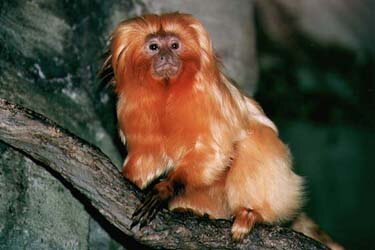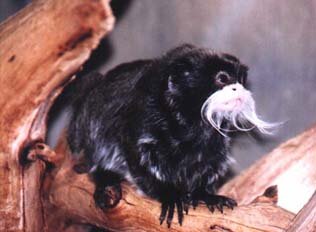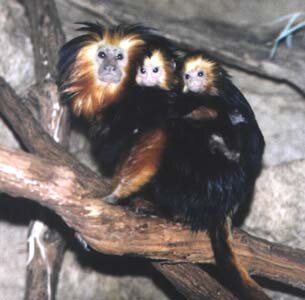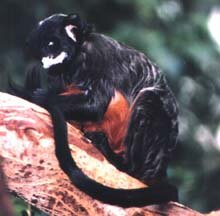TAMARIN FACTS

| Family: Callitrichidae |
Subfamily: Callitrichinae |
| Genus: Saguinus, Leontopithecus |
Species: twelve and four -- |
|
|
-
There are several subspecies and, of course, several of the above classifications are disputed.
Appearance:
There are a great variety of tamarins. Their striking colorations may help to camouflage them in the wild. All are small, relative to most other primates, about 10 inches in body length, give or take a couple, and around 15-20 ounces (some heavier.) Lion tamarins tend to be a bit larger than the other group, have distinctly elongated digits, and, of course, the manes from which they derive their name. The tamarins' ancestral primate nails have evolved to look like claws on all but their large toes. This enables them to climb up and down tree trunks like squirrels. Tamarins can be distinguished from Marmosets, the other large group of callitrichs, only by the lower jaw and teeth. Tamarins have rounded jaws, while the jaws of marmosets are V-shaped, with enlarged incisors.
 Range and Diet:
Range and Diet:
Most tamarins live in northern and central South America, though two species, the red-crested tamarin and the cotton-top tamarin, can also be found in southern Central America. They live in a variety of forest habitats, and are primarily fruit eaters. They'll also feed on seeds, exudates, nectar, and animal prey.
Behavior and Social Structure:
All tamarins are diurnal and arboreal. Though a couple of species will come to the ground for prey, most rarely leave the trees. Most are territorial, with some actively patroling their borders. They exhibit a variable social structure - multimale-multifemale, multimale-1 female, 1 male-1 female, all-male groups and solitary males have all been observed. Group size is normally small. Individuals communicate by vocalizations - a variety of whistles, chirps, trills, and long calls; scent marking; and urine marking. Tamarins have been found in association with cebids, marmosets, and other tamarins. Some will respond to the alarm calls of other tamarins. There is still much to be learned, with field studies lacking for a couple of species.
 Reproduction and Lifespan:
Reproduction and Lifespan:
As with marmosets, dominant females can suppress ovulation of subordinate females and, in some groups, dominant males can lower the sexual activity (and testosterone level) of subordinates. Most seem to have a breeding and birth season. Twins are the norm, though single births and triplets are sometimes seen. Infants are raised communally, with all adults food sharing with the young. Fathers carry the infants quite a bit, sometimes more than the mothers. Participation in the rearing of younger siblings can prepare young females to care for their own offspring. There is still a lot to be learned about tamarin reproductive patterns. The average life span for tamarins seems to be early to mid-teens, although some species can live 20 years, and a couple don't make it into the teens.
 Conservation Status:
Conservation Status:
Lion tamarins are some of the most endangered species in the world, because their natural habitat is the same preferred by humans for agricultural development. Golden-headed lion tamarins are listed as Endangered by USESA, while the black-faced, black, and golden lion tamarins are all considered Critically Endangered, according to IUCN, with a 50% chance of going extinct in the wild within the next 10 years, or within 3 of their generations.
Within Saguinas, half of the species are considered Lower Risk. Emperor tamarins and golden-handed tamarins are listed as Vulnerable (IUCN), with at least a 10% probability of extinction within the next 100 years. Bare-faced tamarins are Threatened (USESA) - likely to become endangered in the near future. Silvery-brown bare-faced (IUCN), red-crested and cotton-top tamarins (USESA) are Endangered - there is at least a 20% chance of them becoming extinct in the wild within the next 20 years, or within 5 of their generations.
 Interesting Tamarin Facts:
Interesting Tamarin Facts:
The bare-faced tamarin has the smallest range of any Amazon primate, corresponding with the constant growth of the city of Manaus.
The saddleback tamarin is the smallest and most widely distributed tamarin.
Red-crested tamarins live in a park in Panama City.
Silvery-brown bare-faced tamarins have been observed coming to the aid of wounded troop members.
Spix's black-mantled tamarin is the only tamarin that forms large, noisy groups - these last only a short period and can contain as many as 40 individuals.
In the 1960s-1970s, more than 30,000 cotton-top tamarins were exported from Colombia for pets and biomedical research.
Golden lion tamarins were the subject of one of the first primate reintroduction programs in the early 80s, when it was discovered that there were more of them living in captivity than in the wild. The success rate of this program has been low.
Current Research with Tamarins:
(Note: The following are examples of recent research done with these primates, it is by no means an exhaustive list. This list will be periodically updated as more information becomes available. Also, though Mindy's Memory Primate Sanctuary DOES NOT support invasive medical research on primates, some articles of this type will be listed - both for information and as examples of the work that is currently being done with these animals.)
Achenbach GG; Snowdon CT
Response to sibling birth in juvenile cotton-top tamarins (Saguinus oedipus). BEHAVIOUR 135(7): 845-862, 1998.
Anonymous.
The captive populations. TAMARIN TALES 2: 4-5, 1998.
Anonymous.
Zoos for the expanding black lion tamarin L. chrysopygus population. TAMARIN TALES 2: 5, 1998.
Baker AJ; Bampi MI
A working group for the pied tamarin, Saguinus bicolor. NEOTROPICAL PRIMATES 7(1): 29, 1999.
Bales K
Research update: Reproductive success and how mom allocates her resources. TAMARIN TALES 2: 5-6, 1998.
Ballou JD; Lacy RC; Kleiman D; Rylands A; Ellis S
LEONTOPITHECUS II: THE SECOND POPULATION AND HABITAT VIABILITY ASSESSMENT FOR LION TAMARINS (LEONTOPITHECUS). FINAL REPORT. Apple Valley, MN, SSC/IUCN Conservation Breeding Specialist Group, 1998, 116+ pp..
Ballou, J D
1995 studbook for the golden lion tamarin. NEOTROPICAL PRIMATES 5(1): 13-14, 1997.
Ballou, J D; Sherr, A
1996 INTERNATIONAL STUDBOOK - GOLDEN LION TAMARIN (LEONTOPITHECUS ROSALIA). Washington, DC, Nat Zool Park, 1997, 109 pp. (Data through 12/31/96)
Bardi M; Petto AJ; Lee-Parritz D
Infant handling and survival in captive cotton-top tamarins and common marmosets. AMERICAN JOURNAL OF PRIMATOLOGY 45(2): 166, 1998. (Abstract)
Bertone ER; Giovannucci EL; King NW Jr; Petto AJ; Johnson LD
Family history as a risk factor for ulcerative colitis-associated colon cancer in cotton-top tamarin. GASTROENTEROLOGY 114(4): 669-674, 1998.
Bezerra EN; Porter LM
[Birth of Saguinus labiatus twins observed in their natural habitat.] NEOTROPICAL PRIMATES 7(1): 27-28, 1999. (Text in Spanish & English)
Bicca-Marques JC; Garber PA
Cognitive aspects of foraging in tamarin single- and mixed-species troops (Saguinus imperator and S. fuscicollis). AMERICAN JOURNAL OF PHYSICAL ANTHROPOLOGY (Suppl 28): 93-94, 1999. (Abstract)
Brack M
Adrenal cortical epithelial cysts in two saddleback tamarins (Saguinus fuscicollis). JOURNAL OF COMPARATIVE PATHOLOGY 119(2): 183-188, 1998.
French, J A
Proximate regulation of singular breeding in callitrichid primates. Pp. 34-75 in COOPERATIVE BREEDING IN MAMMALS. N.G. Solomon; J.A. French, eds. New York, Cambridge Univ Press, 1997.
French, J A; Pissinatti, A; Coimbra-Filho, A F
Reproduction in captive lion tamarins (Leontopithecus): Seasonality, infant survival, and sex ratios. AMERICAN JOURNAL OF PRIMATOLOGY 39(1): 17-33, 1996.
Garber, P A; Kitron, U
Seed swallowing in tamarins: Evidence of a curative function or enhanced foraging efficiency? INTERNATIONAL JOURNAL OF PRIMATOLOGY 18(4): 523-538, 1997.
Kinzey, W G
Synopsis of New World primates: Leontopithecus. Pp. 272-280 in NEW WORLD PRIMATES: ECOLOGY, EVOLUTION, AND BEHAVIOR. W.G. Kinzey, ed. New York, Aldine de Gruyter, 1997.
Kinzey, W G
Synopsis of New World primates: Saguinus. Pp. 289-296 in NEW WORLD PRIMATES: ECOLOGY, EVOLUTION, AND BEHAVIOR. W.G. Kinzey, ed. New York, Aldine de Gruyter, 1997.
Kleiman DG; Mallinson JJC
Recovery and management committees for lion tamarins: Partnerships in conservation planning and implementation. CONSERVATION BIOLOGY 12(1): 27-38, 1998.
Lamprey V
A review of the mating system of captive cotton-top tamarins. IZN [INT ZOO NEWS] 45(3): 146-149, 1998.
Mallinson JJC
A 'case study': Partnerships and conservation initiatives resulting from a population viability assessment (PVA) workshop for the genus Leontopithecus. ZOOLOGISCHE GARTEN 67(6): 355-363, 1997.
McGrew, W C
Sex differences in the family life of cotton-top tamarins: Socioecological validity in the laboratory? Pp. 95-107 in NEW WORLD PRIMATES: ECOLOGY, EVOLUTION, AND BEHAVIOR. W.G. Kinzey, ed. New York, Aldine de Gruyter, 1997.
Pinto, L P de S; Tavares, L I; Dietz, J
The golden-headed lion tamarin - L. chrysomelas. TAMARIN TALES 1: 4-5, 1997.
Pissinatti, A
The Rio de Janeiro Primate Center (CPRJ). TAMARIN TALES 1: 12-13, 1997.
Pryce CR
Evolutionary and comparative biology: Their significance for callitrichid research. Pp. 119-127 in HANDBOOK: MARMOSETS AND TAMARINS IN BIOLOGICAL AND BIOMEDICAL RESEARCH.. Pryce C, ed. Salisbury, UK, DSSD Imagery, 1997.
Queralt AM; Vea JJ
Parental division of infant-care in the pygmy marmoset (Cebuella pygmaea) and the cotton-top tamarin (Saguinus oedipus). PRIMATE REPORT (50): 3-13, 1998. (Spanish summary)
Rapaport, L G
Food sharing in golden lion tamarins (Leontopithecus rosalia): Provisioning of young, maintenance of social bonds, and resource constraints. DISSERTATION ABSTRACTS INTERNATIONAL A58(6): 2278, 1997. (To order: #AAD97-36124. University Microfilms, Inc, Ann Arbor, MI 48106)
Robert N; Carroll JB
Comparative pathological-clinical aspects of captive callitrichids at the Jersey Wildlife Preservation Trust. Pp. 102-109 in HANDBOOK: MARMOSETS AND TAMARINS IN BIOLOGICAL AND BIOMEDICAL RESEARCH.. Pryce C, ed. Salisbury, UK, DSSD Imagery, 1997.
Ruivo EB
Emperor tamarins in Europe. NEOTROPICAL PRIMATES 6(3): 93-94, 1998.
Sainsbury, A W
The humane control of captive marmoset and tamarin populations. ANIMAL WELFARE 6(3): 231-242, 1997.
Sanchez S; Pelaez F; Gil-Burmann C; Kaumanns W
Costs of infant-carrying in the cotton-top tamarin (Saguinus oedipus). AMERICAN JOURNAL OF PRIMATOLOGY 48(2): 99-111, 1999.
Sanchez S; Pelaez F; Kaumanns W; Heymann EW
Mothers of cotton-top tamarins (Saguinus oedipus) benefit from helping behaviour. FOLIA PRIMATOLOGICA 69(4): 212, 1998. (Abstract)
Santos, C V; French, J A; Otta, E
Infant carrying behavior in callitrichid primates: Callithrix and Leontopithecus. INTERNATIONAL JOURNAL OF PRIMATOLOGY 18(6): 889-907, 1997.
Saunders KE; Shen Z; Dewhirst FE; Paster BJ; et al.
A novel Helicobacter sp. isolated from cotton-top tamarins (Saguinus oedipus) with colitis. GUT 43(Suppl): A117, 1998. (Abstract)
Saunders KE; Shen ZL; Dewhirst FE; Paster BJ; Dangler CA; Fox JG
Novel intestinal Helicobacter species isolated from cotton-top tamarins (Saguinus oedipus) with chronic colitis. JOURNAL OF CLINICAL MICROBIOLOGY 37(1): 146-151, 1999.
Saunders, K E; Shen, Z; Jackson, L; Lee-Parritz, D; et al
Intestinal Helicobacter spp. associated with inflammatory bowel disease and colon cancer in a colony of cotton-top tamarins (Saguinus oedipus). CONTEMPORARY TOPICS IN LABORATORY ANIMAL SCIENCE 36(4): 52-53, 1997. (Abstract) Reprinted in: Lab Anim Sci 47(4): 441.
Savage, A; Giraldo, H; Soto, L
Developing a conservation action program for the cotton-top tamarin (Saguinus oedipus). Pp. 97-111 in PRIMATE CONSERVATION: THE ROLE OF ZOOLOGICAL PARKS. J. Wallis, ed. Location?, Amer Soc of Primatol, 1997.
Schoepel M
EEP studbook for the cotton-top tamarin, Saguinus oedipus. NEOTROPICAL PRIMATES 6(1): 22, 1998.
Souza de Oliveira M; Lopes FA; Alonso C; Yamamoto ME
The mother's participation in infant carrying in captive groups of Leontopithecus chrysomelas and Callithrix jacchus. FOLIA PRIMATOLOGICA 70(3): 146-153, 1999.
Stoinski, T; Beck, B; Bowman, M; Lehnhardt, J
The Gateway Zoo Program: A recent initiative in golden lion tamarin reintroductions. Pp. 113-129 in PRIMATE CONSERVATION: THE ROLE OF ZOOLOGICAL PARKS. J. Wallis, ed. Location?, Amer Soc of Primatol, 1997.
Tardif, SD.
The bioenergetics of parental behavior and the evolution of alloparental care in marmosets and tamarins. In: Pp. 11-33 in COOPERATIVE BREEDING IN MAMMALS. N.G. Solomon; J.A. French, eds. New York, Cambridge Univ Press, 1997.
Wood JD; Peck OC; Tefend KS; Rodriguez-M MA; Rodriguez-M JV; Hernandez-C JI; Stonerook MJ; Sharma HM
Colitis and colon cancer in cotton-top tamarins (Saguinus oedipus oedipus) living wild in their natural habitat. DIGESTIVE DISEASES AND SCIENCES 43(7): 1443-1453, 1998.
References:
Rowe N (1996) The Pictorial Guide to the Living Primates. East Hampton: Pogonias Press
Sleeper B (1997) Primates. San Francisco: Chronicle Books
